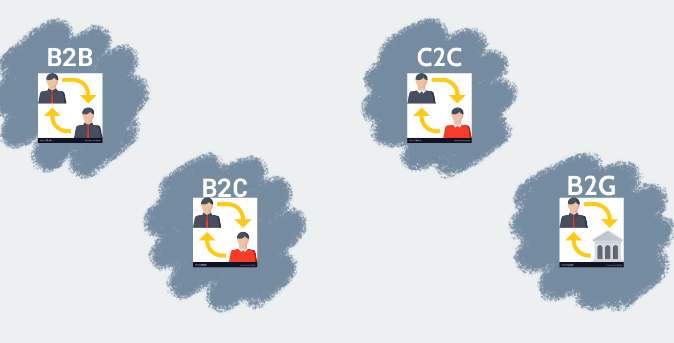Selling is a systematic process. And the better this process is organized, the greater success can be achieved. Different areas of sales have their own peculiarities: from numerous types of commercial relations and the portrait of the target audience to the specifics of the sales cycle and business building models. What is the difference between B2B, B2C, B2G, and C2C and what should you know about each of these segments?
Famous “players”
The common abbreviations B2B and B2C refer to commercial relationships between a business (seller) and an end customer (business or individual, respectively). They describe a market niche and allow you to quickly assess the specifics of a business.
B2B – “business to business”
The clients of B2B companies are other businesses and enterprises. This includes not only the means of production, but also services or outsourcing. That is, the size of such a company can vary considerably: a family restaurant may be the end buyer of powerful food processors produced by a factory. And vice versa: a small IT company can provide a software product to several corporations. In general, the product of a company operating in the B2B segment is focused on specific consumers.
In B2B sales, it is important to remember that:
- a purchase in this segment is driven by the need to solve a specific problem. Therefore, marketing should be aimed at revealing the benefits that the business will receive from the purchase;
- the number of customers is limited, so it is important to conduct targeted work and focus on high-quality negotiations, presentation of your product and analysis of the decision-making process in the client’s company;
- there are very marginal niches in the B2B segment: sometimes it is more profitable to make one large transaction than a dozen small ones.
B2C – “business to consumer”
B2C is an acronym for businesses that sell goods and services to customers for personal use. It can be a large hypermarket, a small hairdresser, or a consulting center. The industry includes retail outlets, food outlets, consumer services (from car rental to beauty salons), and e-commerce (paid online services, online stores, etc.).
Specifics of selling B2C businesses:
- The most important thing to consider when organizing sales and advertising campaigns in this segment is that purchases are made based on subjective desires, and rationality does not always prevail;
- attention is focused on the needs of entire groups of people, not specific consumers. Offers are as universal as possible to reach as many potential buyers as possible.
- Successful advertising campaigns + good service are the main components of success in B2C sales. The competition in this segment is very high, so it is worth finding and formulating a successful USP.
New types
B2G – “business to government”
B2G refers to the sphere of relations between businesses and government agencies and institutions. Relations in this sector are clearly regulated by the legislation of each country and are based on public procurement. Every step of the private sector is strictly regulated and checked: procurement procedures, opportunities, and restrictions.
Such commercial relations have a number of specific features:
- tender procurement system;
- the complex structure of the decision-making mechanism;
- stability of business relations;
- involvement of administrative resources;
- financial conditions (complicated payment system, dependence on the state budget).
The state interacts with business through procurement, in which it is the initiator. Another way of interaction is through public-private partnerships, which are created to solve complex socially important tasks. In this case, businesses invest in various government projects.
The most successful solution for selling in this area is to work with a specialist who knows the intricacies of public procurement and the nuances of organizing the process of interaction between business and the state. This includes searching for information about upcoming procurements, searching for tenders, and preparing the correct applications. The fulfillment of obligations must be approached with the utmost care and responsibility.
Despite the difficulties of doing business in the B2G segment (dependence on employee qualifications, bureaucracy, dependence on uncontrolled structures and processes), there are a number of advantages
- work according to a clear algorithm
- the possibility of long-term planning;
- work with large orders.
C2C – “consumer to consumer”
The type of consumer-to-consumer relationship refers to online and offline sales in which the seller and buyer are individuals. Most often, the seller is not officially an entrepreneur. The peculiarity of C2C is the rapid change of seller-buyer roles.
This area has a lot in common with B2C:
- the purpose of the purchase is personal use;
- small average check;
- small volume of orders with a large number of customers;
- advertising campaigns are targeted at certain groups of consumers, the number of which is unlimited in the group itself.
Often, third parties (marketplaces or newspapers with ads) become intermediaries in such sales. Therefore, the types of commerce in this area depend on the type of intermediary:
online platforms – on such resources, individuals either sell goods once or do so systematically. In the second case, they are essentially engaged in unregistered business activities. Different platforms have their own limitations that should be taken into account;
Print and electronic media – newspapers and classifieds magazines publish offers from “sellers” with whom potential buyers contact directly;
auctions – in addition to facilitating the sale, an intermediary provides additional services, such as appraisal of goods, sales support and security.

